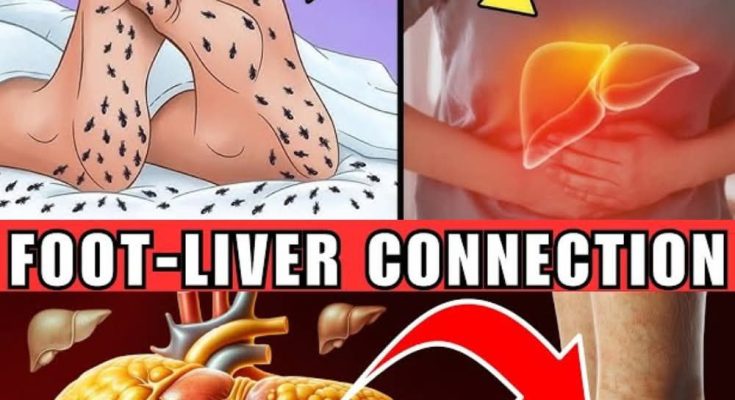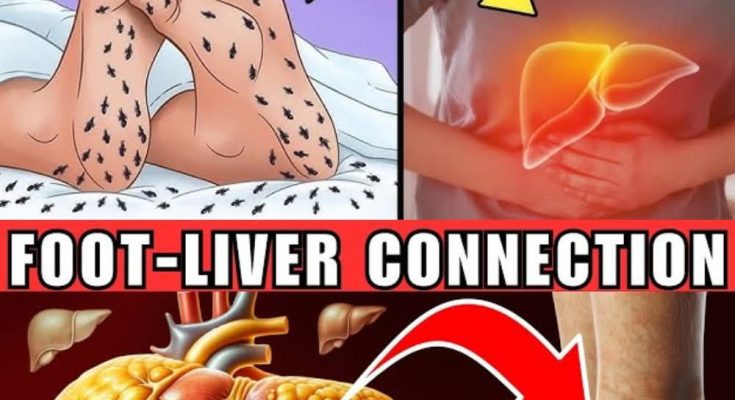How Your Feet Are Warning You About Liver Problems: What You Need to Know


Your body is constantly trying to communicate with you, and one of the most overlooked signs of potential health issues often comes from your feet. While many people focus on common symptoms like fatigue or abdominal discomfort when it comes to liver problems, your feet may also give you vital clues that something is wrong. In this article, we’ll explore how your feet can serve as warning signs for liver issues and what to look for.
1. Swollen Feet and Ankles: A Red Flag for Liver Disease
One of the most common signs that your liver may be under stress is swelling in the feet and ankles. This condition, also known as edema, occurs when the liver is unable to produce enough albumin, a protein that helps keep fluid in the bloodstream. As a result, fluid leaks into the surrounding tissues, causing swelling, particularly in the lower extremities.
What You Should Know:
-
Swollen feet can indicate liver cirrhosis or liver failure, especially when the swelling is accompanied by other symptoms such as jaundice or abdominal bloating.
-
If you notice persistent swelling that doesn’t go away with rest or elevation, it’s important to consult with a healthcare professional to rule out liver-related issues.
2. Jaundice: Yellowing of the Skin and Feet
Jaundice refers to the yellowing of the skin and the whites of the eyes, and it’s often one of the most noticeable signs of liver dysfunction. However, jaundice can also affect your feet, making them appear yellowish in color. This happens because the liver is no longer able to properly filter bilirubin, a byproduct of red blood cell breakdown. When bilirubin builds up in the bloodstream, it causes the yellowish tint seen in the skin and eyes.
What You Should Know:
-
Jaundice in your feet could signal hepatitis, cirrhosis, or liver cancer.
-
If you notice a yellowish tint to your feet or skin, along with other symptoms like fatigue, nausea, or dark urine, it’s crucial to seek medical attention immediately.
3. Itchy Feet: A Possible Sign of Cholestasis
If your feet are itching persistently, especially in the absence of a rash or any apparent cause, this could be a sign of cholestasis, a condition where bile flow from the liver is blocked. When bile isn’t properly excreted, it can build up in the bloodstream, causing itching, particularly on the soles of the feet and palms.
What You Should Know:
-
Cholestasis can occur due to liver diseases such as hepatitis or cirrhosis.
-
Itchy feet, combined with other symptoms like dark urine, pale stools, and fatigue, should be investigated by a healthcare provider to check for liver problems.
4. Pain in the Feet: Could Indicate Liver Inflammation
Foot pain, especially when accompanied by tenderness, can sometimes be linked to liver inflammation. This discomfort may result from the accumulation of toxins or metabolic waste products that the liver can no longer filter out properly. Additionally, conditions like fatty liver disease can lead to generalized discomfort or pain, which may extend to your feet.
What You Should Know:
-
If your feet are sore, swollen, or painful, and these symptoms persist even after resting or elevating them, this could be an indicator that liver inflammation is affecting your body.
-
Always consult a doctor if you experience persistent pain or discomfort in your feet, especially when it is linked to other signs of liver issues.
5. Changes in Toenail Color or Texture
Liver problems can also manifest in the appearance of your toenails. In some cases, yellow or pale toenails may be a warning sign of liver disease. This happens because the liver’s inability to properly process and detoxify the body can lead to nutrient deficiencies and poor circulation, which can affect the health of your nails. Additionally, brittle, discolored nails can be a sign of a weakened immune system, which may be linked to liver disease.
What You Should Know:
-
If your toenails become yellow or develop unusual texture changes (such as becoming thickened or ridged), along with other liver-related symptoms, it may indicate a liver problem.
-
It’s important to monitor your toenail health, and if any changes occur alongside other symptoms like fatigue or jaundice, seek professional medical advice.
6. Cold Feet: Poor Circulation Linked to Liver Dysfunction
Poor circulation is another symptom that can be connected to liver problems. The liver plays a key role in regulating blood flow and removing toxins from the bloodstream. When the liver is struggling, it can affect circulation, leading to cold feet and hands, especially in the lower extremities.
What You Should Know:
-
If you notice that your feet are consistently cold, especially during warmer weather, it could be a sign of poor circulation linked to liver dysfunction.
-
Cold feet, when combined with fatigue, swelling, or jaundice, may point to a more serious liver condition.
Conclusion: Listen to Your Feet for Liver Health Warnings
Your feet can serve as a critical indicator of your liver health. From swelling and pain to changes in color and texture, these signs can provide valuable clues about potential liver problems. If you notice any of the symptoms mentioned above, particularly in combination with other symptoms like fatigue, jaundice, or abdominal discomfort, it’s essential to consult a healthcare professional.
Taking care of your liver is crucial for maintaining overall health, and paying attention to your feet is one way to catch potential issues early. Always listen to your body and seek medical advice if something doesn’t feel right.
Remember: Early intervention can make all the difference when it comes to liver health.



